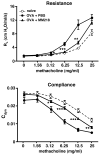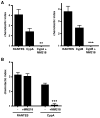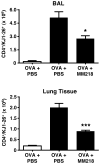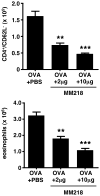A cell-impermeable cyclosporine A derivative reduces pathology in a mouse model of allergic lung inflammation
- PMID: 21057089
- PMCID: PMC3603141
- DOI: 10.4049/jimmunol.1001707
A cell-impermeable cyclosporine A derivative reduces pathology in a mouse model of allergic lung inflammation
Abstract
Although the main regulators of leukocyte trafficking are chemokines, another family of chemotactic agents is cyclophilins. Intracellular cyclophilins function as peptidyl-prolyl cis-trans isomerases and are targets of the immunosuppressive drug cyclosporine A (CsA). Cyclophilins can also be secreted in response to stress factors, with elevated levels of extracellular cyclophilins detected in several inflammatory diseases. Extracellular cyclophilins are known to have potent chemotactic properties, suggesting that they might contribute to inflammatory responses by recruiting leukocytes into tissues. The objective of the present study was to determine the impact of blocking cyclophilin activity using a cell-impermeable derivative of CsA to specifically target extracellular pools of cyclophilins. In this study, we show that treatment with this compound in a mouse model of allergic lung inflammation demonstrates up to 80% reduction in inflammation, directly inhibits the recruitment of Ag-specific CD4(+) T cells, and works equally well when delivered at 100-fold lower doses directly to the airways. Our findings suggest that cell-impermeable analogs of CsA can effectively reduce inflammatory responses by targeting leukocyte recruitment mediated by extracellular cyclophilins. Specifically blocking the extracellular functions of cyclophilins may provide an approach for inhibiting the recruitment of one of the principal immune regulators of allergic lung inflammation, Ag-specific CD4(+) T cells, into inflamed airways and lungs.
Figures









Similar articles
-
Extracellular cyclophilins in health and disease.Biochim Biophys Acta. 2015 Oct;1850(10):2087-95. doi: 10.1016/j.bbagen.2014.11.013. Epub 2014 Nov 18. Biochim Biophys Acta. 2015. PMID: 25445705 Free PMC article. Review.
-
Novel approach to inhibit asthma-mediated lung inflammation using anti-CD147 intervention.J Immunol. 2006 Oct 1;177(7):4870-9. doi: 10.4049/jimmunol.177.7.4870. J Immunol. 2006. PMID: 16982929 Free PMC article.
-
Extracellular cyclophilins contribute to the regulation of inflammatory responses.J Immunol. 2005 Jul 1;175(1):517-22. doi: 10.4049/jimmunol.175.1.517. J Immunol. 2005. PMID: 15972687 Free PMC article.
-
Blocking cyclophilins in the chronic phase of asthma reduces the persistence of leukocytes and disease reactivation.Am J Respir Cell Mol Biol. 2011 Nov;45(5):991-8. doi: 10.1165/rcmb.2011-0007OC. Epub 2011 Apr 14. Am J Respir Cell Mol Biol. 2011. PMID: 21493785 Free PMC article.
-
Functional aspects of extracellular cyclophilins.Biol Chem. 2014 Jul;395(7-8):721-35. doi: 10.1515/hsz-2014-0125. Biol Chem. 2014. PMID: 24713575 Review.
Cited by
-
VBP15, a glucocorticoid analogue, is effective at reducing allergic lung inflammation in mice.PLoS One. 2013 May 7;8(5):e63871. doi: 10.1371/journal.pone.0063871. Print 2013. PLoS One. 2013. PMID: 23667681 Free PMC article.
-
Extracellular cyclophilins in health and disease.Biochim Biophys Acta. 2015 Oct;1850(10):2087-95. doi: 10.1016/j.bbagen.2014.11.013. Epub 2014 Nov 18. Biochim Biophys Acta. 2015. PMID: 25445705 Free PMC article. Review.
-
Extracellular cyclophilin levels associate with parameters of asthma in phenotypic clusters.J Asthma. 2011 Dec;48(10):986-993. doi: 10.3109/02770903.2011.623334. Epub 2011 Oct 14. J Asthma. 2011. PMID: 21999750 Free PMC article.
-
Selection of suitable housekeeping genes for real-time quantitative PCR in CD4(+) lymphocytes from asthmatics with or without depression.PLoS One. 2012;7(10):e48367. doi: 10.1371/journal.pone.0048367. Epub 2012 Oct 24. PLoS One. 2012. PMID: 23110234 Free PMC article.
-
The contribution of cyclophilin A to immune-mediated central nervous system inflammation.J Neuroimmunol. 2020 Feb 15;339:577118. doi: 10.1016/j.jneuroim.2019.577118. Epub 2019 Nov 22. J Neuroimmunol. 2020. PMID: 31790981 Free PMC article.
References
-
- Velazquez J, Teran L. Chemokines and their receptors in the allergic airway inflammatory process. Clinic Rev Allerg Immunol. 2010 Epub ahead of print March 30. - PubMed
-
- Galat A. Peptidylproline cis-trans-isomerases: immunophilins. Eur J Biochem. 1993;216:689–707. - PubMed
-
- Schiene C, Fischer G. Enzymes that catalyse the restructuring of proteins. Curr Opin Struct Biol. 2000;10:40–45. - PubMed
-
- Bukrinsky MI. Cyclophilins: unexpected messengers in intercellular communications. Trends Immunol. 2002;23:323–325. - PubMed
Publication types
MeSH terms
Substances
Grants and funding
LinkOut - more resources
Full Text Sources
Other Literature Sources
Medical
Molecular Biology Databases
Research Materials

